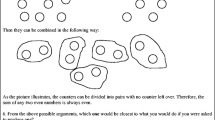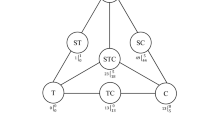Abstract
Proof serves many purposes in mathematics. In this qualitative study of 17 high school mathematics teachers, we found that these teachers perceived that two of the most important purposes for proof in school mathematics were (a) to enhance students’ mathematical understanding and (b) to develop generalized thinking skills that were transferable to other fields of endeavor. We found teachers were divided on the characteristics (or features) of proofs that would serve these purposes. Teachers with less experience tended to believe that proofs in the high school should adhere to strict standards of language and reasoning while teachers with more experience tended to believe that proofs based on concrete or visual features were well suited for high school mathematics. This study has implications for teacher preparation because it appears that there is a wide variation in how teachers think about proof. It seems likely that students would experience proof very differently merely because they were seated in different classrooms.
Similar content being viewed by others
Notes
Proof adapted from Klutch et al. (1991), p. 154.
Proof adapted from http://www.math.csusb.edu/courses/m129/tri180.html. Retrieved in the spring of 2006 but at the time of this writing, this link was dead.
Proof adapted from Nelsen (1993), p. 19.
Problem adapted from Winkler (2004), p. 82.
References
Balacheff, N. (1991). Treatment of refutations: Aspects of the complexity of a constructivist approach to mathematics learning. In E. von Glasersfeld (Ed.), Radical constructivism in mathematics education (pp. 89–110). Netherlands: Kluwer Academic Publishers.
Chazan, D. (1993). High school geometry students’ justification for their views of empirical evidence and mathematical proof. Educational Studies in Mathematics, 24, 359–387.
Davis, P. (1993). Visual theorems. Educational Studies in Mathematics, 24, 333–344.
Davis, P., & Hersh, R. (1981). The mathematical experience. Boston: Birkhauser.
de Villiers, M. (1990). The role and function of proof in mathematics. Pythagoras, 24, 17–24.
Dickerson, D. (2006). Aspects of preservice teachers’ understandings of the purposes of mathematical proof. In S. Alatorre, J. Cortina, M. Sáiz, & A. Méndez (Eds.), Proceedings of the twenty-eighth annual meeting of the North American chapter of the International Group for the Psychology of Mathematics Education (Vol. 2, pp. 710–716). Mérida: Universidad Pedagógica Nacional.
Dickerson, D., & Doerr, H. (2008). Subverting the task: Why some proofs are valued over others in school mathematics. In O. Figueras, J. Cortina, S. Alatorre, T. Rojano, & A. Sepúlveda (Eds.), Proceedings of the joint meeting of PME 32 and PME NA XXX (Vol. 2, pp. 407–414). Morelia, México: Universidad Michoacana de San Nicolás de Hidalgo.
Dubinsky, E. (1986). Teaching mathematical induction I. Journal of Mathematical Behavior, 5, 305–317.
Ernest, P. (1984). Mathematical induction: A pedagogical discussion. Educational Studies in Mathematics, 15, 173–189.
Fischbein, E. (1982). Intuition and proof. For the Learning of Mathematics, 3(2), 9–18.
Goldin, G. (2000). A scientific perspective on structured, task-based interviews in mathematics education research. In A. Kelley & R. Lesh (Eds.), Handbook of research design in mathematics and science education (pp. 517–545). Mahwah: Lawrence Erlbaum Associates, Publishers.
Hanna, G. (1989). Proofs that prove and proofs that explain. In G. Vergnaud, J. Rogalski, & M. Artigue (Eds.), Proceedings of the thirtheenth international conference for the psychology of mathematics education (Vol. 2, pp. 45–51). Paris: University Rene Descartes.
Hanna, G. (1991). Mathematical proof. In D. Tall (Ed.), Advanced mathematical thinking (pp. 54–61). Dordecht: Kluwer Academic Publishers.
Hanna, G. (2000). Proof, explanation and exploration: An overview. Educational Studies in Mathematics, 44, 5–23.
Hanna, G., & Sidoli, N. (2007). Visualization and proof: A brief survey of philosophical perspectives. ZDM Mathematics Education, 39, 73–78.
Harel, G., & Sowder, L. (1998). Students’ Proof schemes: Results from an exploratory study. In A. H. Schoenfeld, J. Kaput, & E. Dubinsky (Eds.), Research in college mathematics education III (pp. 234–283). Providence: American Mathematical Society.
Herbst, P. (2002). Engaging students in proving: A double bind on the teacher. Journal for Research in Mathematics Education, 33(3), 176–203.
Klutch, R., Bumby, D., Collins, D., & Egbers, E. (1991). Integrated mathematics: Course 2. Columbus: Merrill Publishing Co.
Knuth, E. (2002a). Secondary school mathematics teachers’ conceptions of proof. Journal for Research in Mathematics Education, 33(5), 379–405.
Knuth, E. (2002b). Teachers’ conceptions of proof in the context of secondary school mathematics. Journal of Mathematics Teacher Education, 5(1), 61–88.
Lowenthal, F., & Eisenberg, T. (1992). Mathematical induction in school: An illusion of rigor? School Science and Mathematics, 92(5), 233–238.
National Council of Teachers of Mathematics. (1989). Curriculum and evaluation standards for school mathematics. Reston: Author.
National Council of Teachers of Mathematics. (2000). Principles and standards for school mathematics. Reston: Author.
Nelsen, R. (1993). Proofs without words: Exercises in visual thinking. Washington: Mathematical Association of America.
Rodd, M. (2000). On mathematical warrants: Proof does not always warrant, and a warrant may be other than a proof. Mathematical Thinking and Learning, 2(3), 221–244.
Schoenfeld, A. (1985). Mathematical problem solving. London: Academic Press Inc.
Segal, J. (2000). Learning about mathematical proof: Conviction and validity. Journal of Mathematical Behavior, 18(2), 191–210.
Selden, J., & Selden, A. (1995). Unpacking the logic of mathematical statements. Educational Studies in Mathematics, 29, 123–151.
Stylianides, A., Stylianides, G., & Philippou, G. (2004). Undergraduate students’ understanding of the contraposition equivalence rule in symbolic and verbal contexts. Educational Studies in Mathematics, 55, 133–162.
Varghese, T. (2009). Secondary-level student teachers’ conceptions of mathematical proof. Issues in the undergraduate mathematics preparation of school teachers: The Journal, volume 1: Content knowledge. Retrieved from http://www.k-12prep.math.ttu.edu/.
Weber, K. (2010). Mathematics majors’ perceptions of conviction, validity, and proof. Mathematical Thinking and Learning: An International Journal, 12(4), 306–336.
Williams, E. (1979). An investigation of senior high school students’ understanding of the nature of mathematical proof. Unpublished doctoral dissertation. Edmonton: University of Alberta.
Winkler, P. (2004). Mathematical puzzles: A connoisseur’s collection. Natick: A. K. Peters, LTD.
Author information
Authors and Affiliations
Corresponding author
Appendix
Appendix
Odd Squares I
- Claim::
-
If a 2 is odd, then a is odd as well.
- Proof::
-
We will prove the claim by proving the contrapositive: If a is even, then a 2 is even.
Let a = 2n, then a 2 = 4n 2, and a 2 = 2(2a 2). So, a 2 is even.
Therefore if a is even, then a 2 is even and if a 2 is odd, then a is odd.
Odd Squares II
- Claim::
-
If a 2 is odd, then a is odd as well.
- Proof::
-
We will prove the claim by proving the contrapositive: If a is even, then a 2 is even.
Even numbers end in 0, 2, 4, 6, or 8.
The square of any number ending in 0 ends in 0.
The square of any number ending in 2 ends in 4.
The square of any number ending in 4 ends in 6.
The square of any number ending in 6 ends in 6.
The square of any number ending in 8 ends in 4.
These squares are then all even. Therefore, the square of an even number is even.
So if an odd number is a square, then its square root is also odd.
Interior Angles I
- Claim::
-
The sum of the degree measures of the interior angles of a triangle is 180.
- Proof:Footnote
Proof adapted from Klutch et al. (1991), p. 154.
: -

Statements
Reasons
1. Through B, draw \( \overleftrightarrow{ DE}\left\Vert \overline{ AC}\right.. \)
1. Through a point not on a given line, there exists one and only one line parallel to the given line.
2. ∠1 ≅ ∠4, ∠3 ≅ ∠5
2. If two parallel lines are cut by a transversal, then each pair of the alternate interior angles is congruent.
3. ∠4 and ∠ABE are supplementary.
3. Supplement axiom
4. m∠4 + m∠ABE = 180
4. Definition of supplementary angles
5. m∠ABE = m∠2 + m∠5
5. Angle addition axiom
6. m∠4 + m∠2 + m∠5 = 180
6. Substitution axiom
7. m∠1 + m∠4, m∠3 =m∠5
7. Definition of congruent angles
8. m∠1 + m∠2 + m∠3 = 180
8. Substitution axiom
Interior Angles II
- Claim::
-
The sum of the interior angles of a triangle is 180˚.
- Proof:Footnote
Proof adapted from http://www.math.csusb.edu/courses/m129/tri180.html. Retrieved in the spring of 2006 but at the time of this writing, this link was dead.
: -
Cut a triangle from a piece of paper. Arrange it so that its longest side is the base.
Fold the triangle on a line parallel to the base so that the top vertex lies on the base as shown below.

Now fold the triangle so that the right vertex touches the top vertex (in its folded down position). The two parts of the right side of the triangle should line up, and the right part of the bottom side should be folded along itself as shown below.

Fold in the left vertex in the same way.

You should see the three interior angles of the triangle meeting at a point, forming an 180˚ angle with no overlapping.
Quadratic Formula
- Claim::
-
The solution to ax 2 + bx + c = 0 is \( x=\frac{-b\pm \sqrt{b^2-4 ac}}{2a}. \)
- Proof::
-
Solve: ax 2 + bx + c = 0
If: ax 2 + bx + c = 0
Then: \( {x}^2+\frac{b}{a}x+\frac{c}{a}=0 \)
By completing the square, we get:
$$ {\left(x+\frac{b}{2a}\right)}^2-{\left(\frac{b}{2a}\right)}^2+\frac{c}{a}=0 $$Solving this for x, we get the following sequence of steps:
$$ \begin{array}{l}{\left(x+\frac{b}{2a}\right)}^2={\left(\frac{b}{2a}\right)}^2-\frac{c}{a}\hfill \\ {}x+\frac{b}{2a}=\pm \sqrt{{\left(\frac{b}{2a}\right)}^2-\frac{c}{a}}\hfill \\ {}x=-\frac{b}{2a}\pm \sqrt{{\left(\frac{b}{2a}\right)}^2-\frac{c}{a}}\hfill \\ {}x=-\frac{b}{2a}\pm \sqrt{\frac{b^2}{4{a}^2}-\frac{c}{a}}\hfill \\ {}x=-\frac{b}{2a}\pm \sqrt{\frac{b^2}{4{a}^2}-\frac{4 ac}{4{a}^2}}\hfill \\ {}x=-\frac{b}{2a}\pm \frac{\sqrt{b^2-4 ac}}{2a}\hfill \end{array} $$And so the solution to the quadratic equation ax 2 + bx + c = 0 is:
$$ x=\frac{-b\pm \sqrt{b^2-4 ac}}{2a} $$
Completing the Square
- Claim::
-
\( {x}^2+ ax={\left(x+\frac{a}{2}\right)}^2-{\left(\frac{a}{2}\right)}^2 \)
- Proof:Footnote
Proof adapted from Nelsen (1993), p. 19.
: -

Chocolate Bar
You have a rectangular chocolate bar marked into m × n squares, and you wish to break up the bar into its constituent squares. At each step, you may pick up one piece and break it along any of its marked vertical or horizontal lines.

- Claim::
-
Every method finishes in the same number of steps
- Proof:Footnote
Problem adapted from Winkler (2004), p. 82.
: -
Each time you break the bar, you end up with one more piece than you had before. So it will take mn – 1 breaks (no matter how you proceed) to go from one large piece to mn little pieces.
Rights and permissions
About this article
Cite this article
Dickerson, D.S., Doerr, H.M. High school mathematics teachers’ perspectives on the purposes of mathematical proof in school mathematics. Math Ed Res J 26, 711–733 (2014). https://doi.org/10.1007/s13394-013-0091-6
Received:
Revised:
Accepted:
Published:
Issue Date:
DOI: https://doi.org/10.1007/s13394-013-0091-6









